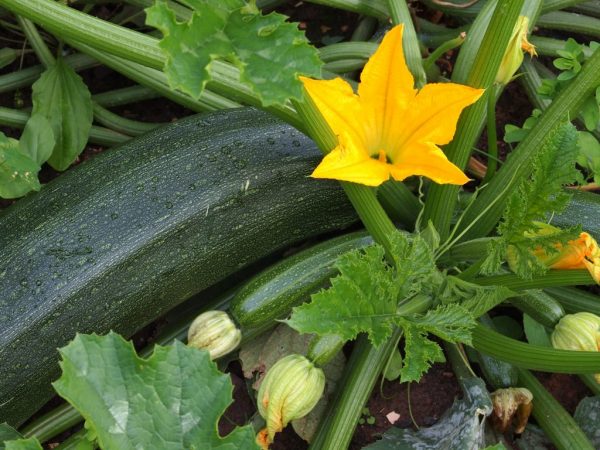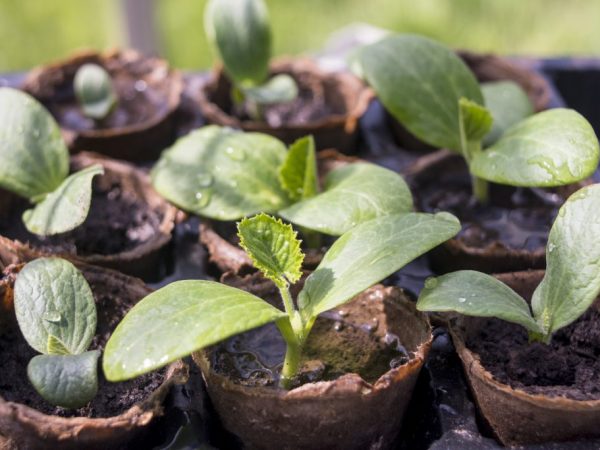Zucchini variety Tsukesh
Zucchini Zucchini is a variety of zucchini, the description of which indicates increased yields and increased shelf life. Thanks to these characteristics, the view of Tsukesh is widespread among summer residents.

Zucchini variety Tsukesh
Characteristics of the variety
According to the description, Tsukesh zucchini belongs to early ripening, ripening 40-50 days from the moment of planting. The time of sowing seeds falls on April - mid-May. They are planted both in a greenhouse and in open soil.
This varietal variety has excellent gastronomic characteristics and is suitable for consumption raw and after preliminary heat treatment.
The fruits have a number of distinctive features:
- cylindrical shape;
- the peel is smooth;
- the color of the zucchini peel is predominantly dark green with light small specks;
- weight of vegetables - 0.9-1 kg, average length - 0.3-0.4 m, diameter - 10-12 cm;
- the flesh is white, crispy, delicate in taste.
Advantages and disadvantages
The Tsukesh marrow variety, universal for growing, has the following positive characteristics:
- shortened (up to 45-50 days) growing season;
- minimal climbing and the absence of thorny foliage on the lashes;
- is formed in a bushy form, which makes it possible to form compact vegetable plantings and save space;
- yield up to 10-12 kg;
- seedlings appear at the same time;
- easily tolerates a drop in temperature, which makes it possible to cultivate the variety in regions with a harsh climate;
- differs in the increased shelf life of ripe fruits;
- resistant to a number of common diseases.
no flaws. Zucchini requires care in the care process; vegetables should not overripe. At the stage of inflorescence formation and fruiting, it is important to monitor sufficient soil moisture.
Landing
The process of preparing seeds for planting begins with their preliminary soaking, and it does not matter whether it is planned to grow zucchini by seedlings, or the seeds will be planted without prior germination.
When soaking seeds, summer residents resort to drugs such as humate and nitrophoska.
When soaking, the seed material is spread in fertilizers diluted to a liquid state and waited for 1 day, after which the seeds soaked in fertilizers are transferred to a moistened cloth (for example, gauze) and the seeds are kept there for 2 days, regularly moistened with water. The optimal temperature regime during this period is 22 ° С.
Germination of seedlings
Prepared seeds of zucchini Tsukesh begin to be planted from the second half of April to the first third of May. Ready-made mixtures or a mixture made independently from humus and peat are suitable for planting. Containers with a volume of up to 0.2 l are filled with the substrate mixture, the substrate is moistened and seeds are placed in it by 2-3 cm.

The humidity level must be observed
Optimal conditions for germinating seedlings:
- maintaining the temperature regime at the level of 18-23 ° С, maximum temperature - 25 ° С;
- regular watering every 5-7 days;
- placement of containers with plantings in a sunlit place;
- humidity level - 70%.
When the first leaves appear, it is required to set the temperature regime no higher than 18-20 ° C, trying to reduce the degree at night to 15 ° C. When there are about 4-5 leaves on the shoots, hilling is carried out, which stimulates the growth of lateral root shoots.
Top dressing of seedlings is carried out 2-3 times:
- a week after the sprouts appeared;
- after with an interval of 10 days.
The following is suitable for feeding squash seedlings:
- bud - 2 g of the drug is dissolved in water and the sprout is watered in an amount of 100 ml;
- effecton and nitrophoska - 1 tsp. per 200 ml per sprout.
The sprouted entrances are transplanted a month later.
Seat selection
Light soils are suitable for Tsukesh zucchini, where potatoes, legumes, onions or cabbage were previously grown. Zucchini are not planted on the ridges where pumpkins grew, because the cultivation of related vegetable crops leads to the accumulation of infectious agents with the simultaneous pulling out of certain micro- and macrocomponents.
A ridge for planting a variety of zucchini Tsukesh is prepared in advance, digging it up in the fall and adding organic matter and mineral fertilizing complexes containing high proportions of phosphorus and nitrogen. Before planting seeds or seedlings, soil soil is dug up, holes are formed into which top dressing is applied. Humus, fertilizer complexes and wood ash are suitable as top dressing.
In unsettled weather conditions, to protect the squash plantings, they are covered with foil or cut plastic bottles.
Sowing depth of seeds - from 5 cm. Sowing width - 0.7-0.9 m. I water directly formed holes, do not moisten the aisles. With high moisture content of the soil, earthen ridges are made.
Care
Caring for the Tsukesha variety differs little from caring for other varietal types of zucchini and includes the following main stages: watering, loosening with the removal of weeds, thinning the bushes, if necessary, and fertilizing with top dressing.
Watering
Zucchini requires frequent watering up to 2 times a week only in dry weather. Under normal climatic conditions, root watering is necessary at intervals of 1 week. Each bush takes 1.5-2 liters.
The optimal time for watering is in the morning or evening.
Loosening and removing weeds

Periodic loosening will increase the yield of plants
Loosening of the soil prevents the formation of a dried earth crust, which interferes with the normal process of aeration of the plant root system. Weed vegetation significantly reduces productivity indicators, because takes a large proportion of the mineral components necessary for the nutrition of vegetable crops. With frequent plantings, thinning is carried out, leaving 1 bush for every 0.7-0.9 m.
Top dressing
For feeding zucchini of the Tsukesha variety, complexes containing potassium and phosphate are suitable. It is also worth using mullein. Fertilizing complexes, which contain chlorine, are inapplicable, because it has a detrimental effect on vegetable crops.
Tsukeshu is usually fed three times during the entire growing season:
- before the beginning of the flowering stage - 1 tbsp. l. nitrophosphate for 1 liter for one sprout;
- at the flowering stage - 1 tbsp. l. fertilizer complex for 1 liter for one bush;
- at the stage of fruit appearance - infusion of mullein or bird droppings, superphosphate, potassium sulfate or urea, 1 tsp. 1 liter for a bush.
Every 10-12 days Tsukeshe needs foliar dressing by spraying with urea solutions.
Collection features
Subject to the main planting dates, which fall in April - May, the Tsukesha zucchini variety ripens by June - August. 10 days before harvesting, the plants stop watering, which provides an increase in the shelf life of vegetables.
Harvesting vegetables is required regularly as they grow, because overgrown fruits lose their gastronomic qualities and at the same time absorb minerals, preventing the plant from bearing fruit.
Diseases
For the Tsukesh zucchini variety, which has sufficient immunity, the following diseases are dangerous:
- powdery mildew;
- anthracnose;
- root rot.
To prevent diseases, the plantings are cared for and do not allow them to thicken. Onions and garlic planted around the perimeter help to fight the spread of infections. During the growing season, with an interval of 1 week, planting is treated with solutions with laundry soap or soda ash.
Conclusion
A weakly branched zucchini variety called Tsukesha produces dark green fruits with light specks. The vegetable is in demand among summer residents, because cultivated both in the greenhouse and in the open field. Seeds are sown mainly by the non-seedling method, however, it will be possible to speed up the harvest if Tsukeshu is planted with seedlings. The yield is high, and the harvested vegetables retain their original appearance and gastronomic qualities for a long time.

